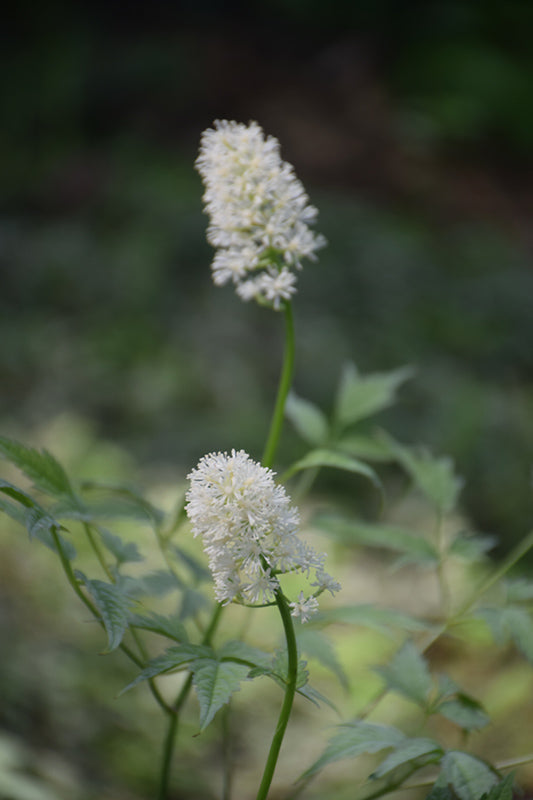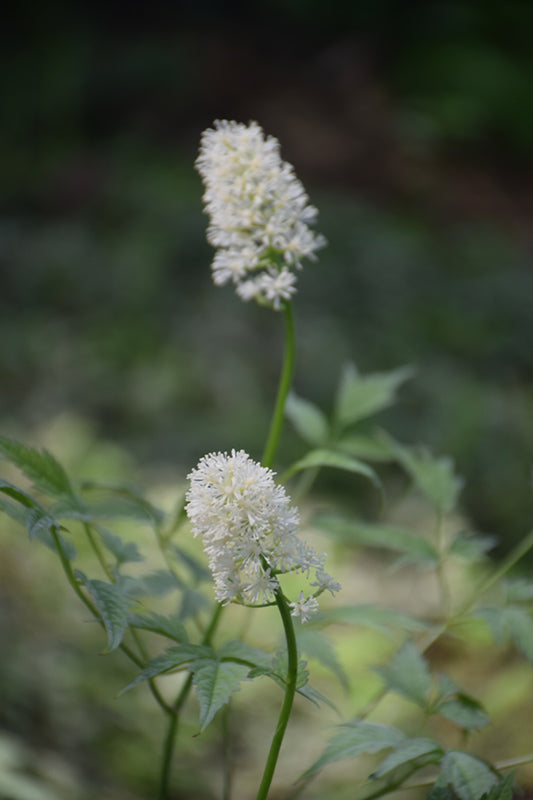Actaea pachypoda 'Misty Blue' (White Baneberry)
Misty Blue White Baneberry is an herbaceous perennial with an upright spreading habit of growth. Its medium texture blends into the garden, but can always be balanced by a couple of finer or coarser plants for an effective composition.
This is a relatively low maintenance plant, and is best cleaned up in early spring before it resumes active growth for the season. It is a good choice for attracting birds and bees to your yard, but is not particularly attractive to deer who tend to leave it alone in favor of tastier treats. It has no significant negative characteristics.
Misty Blue White Baneberry features showy clusters of lightly-scented white flowers rising above the foliage from late spring to early summer. Its attractive serrated compound leaves remain bluish-green in colour with hints of blue throughout the season. It features an abundance of magnificent white berries with black spots from late summer to early fall. The red stems are very colorful and add to the overall interest of the plant.
Misty Blue White Baneberry will grow to be about 28 inches tall at maturity, with a spread of 24 inches. Its foliage tends to remain dense right to the ground, not requiring facer plants in front. It grows at a medium rate, and under ideal conditions can be expected to live for approximately 10 years. As an herbaceous perennial, this plant will usually die back to the crown each winter, and will regrow from the base each spring. Be careful not to disturb the crown in late winter when it may not be readily seen!
This plant does best in partial shade to shade. It does best in average to evenly moist conditions, but will not tolerate standing water. It is not particular as to soil pH, but grows best in rich soils. It is somewhat tolerant of urban pollution. This is a selection of a native North American species, and parts of it are known to be toxic to humans and animals, so care should be exercised in planting it around children and pets. It can be propagated by division; however, as a cultivated variety, be aware that it may be subject to certain restrictions or prohibitions on propagation.
Details
Botanical Name
Actaea pachypoda 'Misty Blue'
Common Name
Misty Blue White Baneberry
Hardiness Zone
- 3
Appearance
Max Height
3 Feet
Max Spread
24 Inches
Plant Form
- Upright Spreading
Foliage Colour
- Green
Fall Colour
Flower Colour
- White
Edible
Edible Component
Edible Harvest Period
Edible Use
Fruit Colour
Growing
Flowering Period
From Late Spring To Early Summer
Moisture
Average To Moist
Sunlight
Shade
Maintenance
Deer Resistance
Yes
Your cart

Actaea pachypoda 'Misty Blue' (White Baneberry)
Misty Blue White Baneberry is an herbaceous perennial with an upright spreading habit of growth. Its medium texture blends into the garden, but can always be balanced by a couple of finer or coarser plants for an effective composition.
This is a relatively low maintenance plant, and is best cleaned up in early spring before it resumes active growth for the season. It is a good choice for attracting birds and bees to your yard, but is not particularly attractive to deer who tend to leave it alone in favor of tastier treats. It has no significant negative characteristics.
Misty Blue White Baneberry features showy clusters of lightly-scented white flowers rising above the foliage from late spring to early summer. Its attractive serrated compound leaves remain bluish-green in colour with hints of blue throughout the season. It features an abundance of magnificent white berries with black spots from late summer to early fall. The red stems are very colorful and add to the overall interest of the plant.
Misty Blue White Baneberry will grow to be about 28 inches tall at maturity, with a spread of 24 inches. Its foliage tends to remain dense right to the ground, not requiring facer plants in front. It grows at a medium rate, and under ideal conditions can be expected to live for approximately 10 years. As an herbaceous perennial, this plant will usually die back to the crown each winter, and will regrow from the base each spring. Be careful not to disturb the crown in late winter when it may not be readily seen!
This plant does best in partial shade to shade. It does best in average to evenly moist conditions, but will not tolerate standing water. It is not particular as to soil pH, but grows best in rich soils. It is somewhat tolerant of urban pollution. This is a selection of a native North American species, and parts of it are known to be toxic to humans and animals, so care should be exercised in planting it around children and pets. It can be propagated by division; however, as a cultivated variety, be aware that it may be subject to certain restrictions or prohibitions on propagation.
Pot Size
- #1
Height or Caliper
- -
Location
Are you a wholesale customer?
The Green Thumb Nurseries website is for wholesale customers only. If you're looking for the retail Garden Centre, we have a separate site for your shopping needs!
-
Customer Care
(250) 758-0808 ext. 2
sales@greenthumbwholesale.com -
Visit Us
6261 Hammond Bay Rd
Nanaimo, BC V9T 5M4 -
Wholesale Nursery Hours
Mon - Fri 8:00AM - 4:30PM
Not open to the public, Check in at the Office When Visiting -
Retail Garden Centre Hours
Every Day
9:00AM - 5:00PM

